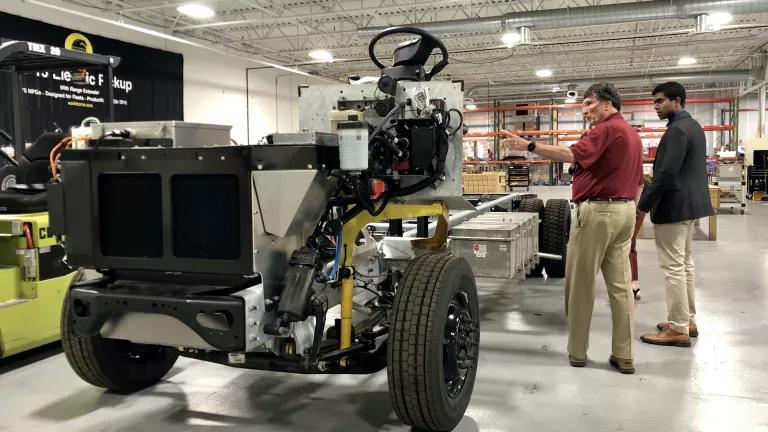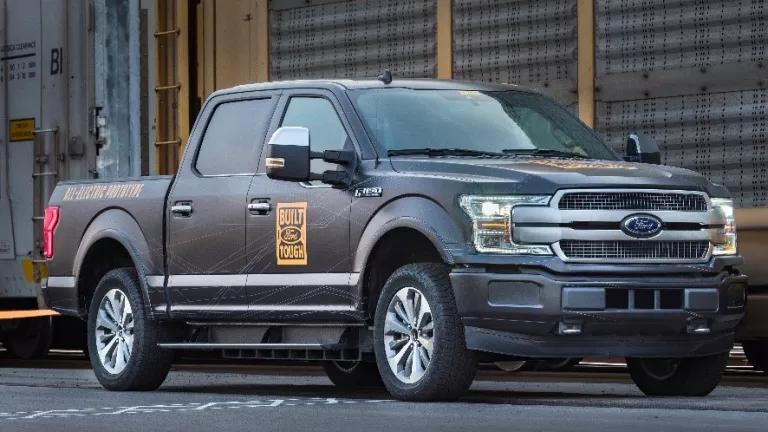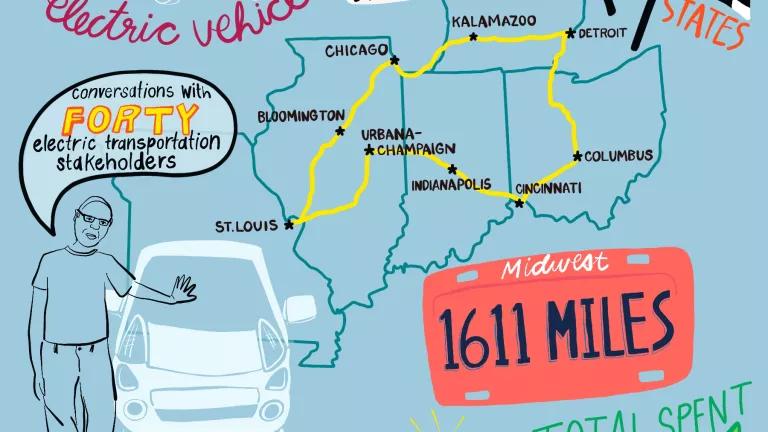Beyond Cars: Electrifying Trucks and Planes
During our EV road trip through the Midwest, we got a glimpse of the many modes of transportation that are prime for electrification.

The drivetrain, or "skateboard", from an older iteration of Workhorse's medium-duty electric truck
This is the twelfth blog in a series about our Midwest electric vehicle adventure.
During our EV road trip through the Midwest, we got a glimpse of the many modes of transportation that are prime for electrification. While long-range electric passenger vehicles like the Tesla Model 3 and the Chevy Bolt get a lot of attention, 59 percent of emissions from the transportation sector actually comes from vehicles that are not passenger cars.
This two-part blog provides an overview of vehicle electrification beyond cars. Part 1 focused on the emerging technology behind electric pickups and buses. It outlined efforts in developing new electric vehicles as well as experiences deploying these technologies, such as electric school buses, in various municipalities.
Here, Part 2 examines the electrification of two kinds of vehicles that are commonly used for transporting goods—medium- and heavy-duty trucks—as well as the increasingly crowded, nascent field of electric aviation. Electric delivery trucks have improved substantially in recent years, and industry has taken notice. Larger electric vehicles, however, have been slower to reach price parity with diesel alternatives, but have been a recent focus of both manufacturers and customers alike.
Your electric delivery is just around the corner
Medium- and heavy-duty trucks make up over 23 percent of U.S. transportation emissions. Within that segment, delivery trucks in particular are strong candidates for electrification. The U.S. Postal Service (USPS) and several companies including UPS and FedEx have begun adding electric delivery trucks to their fleets--not just for environmental reasons, but also because of the economic value they provide.
Driving an EV can save companies money in the long run, both because electric vehicles are more efficient than combustion engine vehicles and because electricity is cheaper than gasoline. The more miles you drive, the more money you’re going to save in an EV over a gasoline or diesel-powered vehicle.
That cost-saving applies to all kinds and sizes of electric vehicles, but it’s especially meaningful for delivery companies. Delivery companies operate their vehicles much more heavily than the average American passenger car, which is only driven less than 4 percent of the year. Considering that UPS, for example, logs more than 3 billion miles across its fleet in a year, it’s unsurprising that delivery companies would have a keen appetite for reducing their expenses per mile traveled.
Improvements in truck design and battery manufacturing have also brought down the upfront cost differential and provide even greater lifetime savings. Workhorse, an electric truck manufacturer based out of Loveland, Ohio, has a custom-built, lightweight truck that boasts comparable upfront costs to gas- or diesel-powered delivery trucks. For vehicles that spend so much time on the road, electric trucks also provide the benefit of reduced downtime and reduced cost for maintenance due to the comparative simplicity of their electric powertrains.
And as if these cost savings weren’t enough, the improved torque of electric vehicles allows them to accelerate more rapidly from a standstill, say at a stoplight, thus reducing the time of each trip. Again, this applies to all electric vehicles, but is especially important to delivery companies. The amazing torque of electric trucks allows the companies to squeeze in more deliveries each day, and ultimately obtain more value for each hour spent driving.
This great potential for electrification of medium-duty delivery trucks has not gone unnoticed: UPS has requested nearly 1,000 electric trucks from Workhorse and FedEx has acquired 1,000 from Chanje. The potential next (huge) domino to fall is the USPS, which is considering going fully electric for their next order of 180,000 trucks. USPS expects to save between $4,000 and $6,000 per truck each year by switching to electric-powered trucks, all while substantially reducing emissions.
Electrification for the long haul
Heavy-duty trucks carry very large payloads—over 26,000 pounds, to be precise. Though there have been a few high-profile announcements about electric heavy-duty trucks, including UPS reserving 125 of Tesla’s upcoming semi-truck, many experts remain skeptical about our ability to electrify the majority of heavy-duty trucks. Compared to medium-duty vehicles, which McKinsey predicts may reach near 20 percent of market share by 2030, heavy-duty trucks are optimistically projected to reach just around 2 percent.
While these trucks would benefit from electrification for many of the reasons mentioned above—especially high utilization leading to significant cost reduction potential—the sheer weight of goods that needs to be transported and the daunting distances between deliveries can be an obstacle. McKinsey’s analysis finds that an average daily distance of about 125 miles is optimal for electrification, but since heavy-duty trucks often drive much further, they require larger and heavier battery packs. That limits either the cargo that can be carried or the range the truck can travel.
With such large batteries and limited required downtime for drivers on long routes, large electric trucks must be able to rapidly charge using high-powered fast chargers. Some chargers being installed today are designed to provide up to 350 kW of power—over 70,000 times the power provided through a phone charger. Such charging can lead to significant spikes in demand on the power grid, which can be avoided with large, but expensive, on-site batteries at charging stations.
Alternatively, several companies are considering building battery swap stations for electric truck drivers to replace discharged, or empty, batteries with full ones. This system would allow drivers to get back on the road in a matter of minutes, and the replacement batteries could charge more gradually and without straining the power grid. While companies like NIO have already begun deploying these battery swap stations in China, the business case for battery swapping is currently limited by the cost of batteries: the cost per vehicle would increase to account for the number of batteries required.

A heavy-duty truck behind charging infrastructure it may soon use
Despite these challenges, McKinsey expects heavy-duty electric trucks will reach cost parity around 2030. After that, all the advantages of electrification that we have already mentioned will drive increased electric truck adoption.
Not wanting to put all their eggs in one basket, the trucking industry has also been exploring alternatives beyond batteries to decarbonize the heavy-duty sector. Startups like Nikola are working on a hydrogen-powered fuel cell truck. These vehicles have the distinct advantage of being able to refuel within minutes, mirroring the refueling experience of a conventional diesel truck. However, scarce hydrogen infrastructure, especially outside of California, has limited the growth of fuel cell trucks so far.
Your electric flight is (almost) cleared for takeoff
As if the trucking market wasn’t challenging enough, several entrepreneurs have recently turned their attention to the skies. Electric flight is the newest game in town, with companies like Joby Aviation and Zunum Aero securing funding from aviation giants including Boeing and JetBlue. Similar to heavy-duty trucks, the weight of batteries has proven to be a major obstacle to full electrification, and several of these startups have prioritized the development of hybrid planes to partially decarbonize air travel. Once the energy density of batteries sufficiently improves, providing the same energy with less weight, these companies intend to build fully-electric planes. Researchers at the University of Illinois Urbana-Champaign have conducted simulations and technoeconomic analyses that confirm substantial fuel efficiency improvements from hybrid-electric planes, especially for shorter distance travel.
For longer distances, researchers are cautiously optimistic about hydrogen playing an important role, and NASA recently dedicated $6 million to develop this technology. Massachusetts-based Alaka’i Technologies recently unveiled their hydrogen “flying car”, which aims to compete with companies like Uber and Lilium in the development of electric vertical takeoff and landing (EVTOL) aircrafts that are meant to transport small groups of passengers along short hops between cities.
The future is electric
No matter what corner of the transportation sector you look at, there are groups in academia and industry conducting promising research and development to electrify and decarbonize vehicles. The advancements and breakthroughs being made in the light-duty vehicle segment, such as battery costs decreasing and energy densities improving, will have huge impacts on the development of electric heavy-duty trucks or airplanes. Similarly, learning that occurs through developing charging infrastructure for heavy-duty electric trucks will likely benefit passenger EV owners as well.
Pickups, buses, trucks, planes, and other vehicles will need to undergo a rapid and vast transformation in coming years in order to reduce emissions from the transportation sector. Fortunately, several promising electric technologies are up to the task. Policymakers must embrace their ability and responsibility to help provide clean air and affordable, reliable access to electric vehicles of all shapes and sizes by supporting the development of strategic technologies and infrastructure.
We went on a Midwest electric vehicle road trip to talk about transportation policy, highlight the already booming benefits of electric vehicles to local economies, and shatter stereotypes about what it means to be an electric vehicle driver. We’re blogging about our findings, including tips for other aspiring roadtrippers and policy suggestions for further progress.
Other blogs related to our electric adventure include:
Driving (on) Clean Energy: Touring the Midwest in an EV
State of the States: EVs and EV Policy in the Midwest
Road Trip Report: How Ohioans Buy EVs (It Should Be Easier)
Avoiding Range Anxiety with an EV Road Trip Checklist
Road Trip Report: Midwest Cities Move Multimodal
Midwest Electric Vehicles in 5 Maps
Electric Vehicle Charging 101
Road Trip Report: On Charging Champions and Public Policy
Electric Vehicles 101
This Is What the EV Revolution Looks Like
Beyond Cars 1: Electrifying Pickups and Buses



